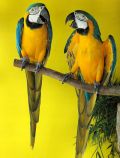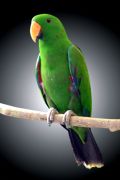 BLACK CAP LORY Lorius lory
BLACK CAP LORY Lorius lory |
 |
The Black-capped Lory inhabits the primary forest and forest edges in most lowland areas up to 1000m (sporadically to 1750m), but not monsoon forest or coconut plantations. It is usually found in pairs and occasionally in groups of 10 or more. Their diet includes pollen, nectar, flowers, fruit and insects. |
 BLACK PALM COCKATOO (GOLIATH) Probosiger goliath
BLACK PALM COCKATOO (GOLIATH) Probosiger goliath |
 |
It measures around 55-60 cm (22-24 in) in length and weighs between 500-1,000 g. It is a distinctive bird with a large crest and has one of the largest bills of any parrots (only the Hyacinth Macaw's is larger). This powerful bill enables Palm Cockatoos to eat very hard nuts and seeds that other species have difficulty accessing. The bill is unusual as the lower and upper mandibles do not meet for much of its length, allowing the tongue to hold a nut against the top mandible while the lower mandible works to open it. The Palm Cockatoo also has a distinctive red cheek patch that changes colour when the bird is alarmed or excited. |
 BLUE & GOLD MACAW Ara ararauna
BLUE & GOLD MACAW Ara ararauna |
 |
A member of the group of large Neotropical parrots known as macaws. It breeds in forest (especially varzea, but also in open sections of Terra Firme) and woodland of tropical South America from Trinidad and Venezuela south to Brazil, Bolivia, Colombia, and Paraguay. It barely extends into Central America, where restricted to Panama. It is an endangered species in Trinidad, and is on the verge of being extirpated from Paraguay, but still remains widespread and fairly common in a large part of mainland South America. |
 CHATTERING LORY Lorius garrulus garrulus
CHATTERING LORY Lorius garrulus garrulus |
 |
The Chattering Lory, Lorius garrulus is a forest-dwelling parrot endemic to North Maluku, Indonesia. It is considered vulnerable, the main threat being from trapping for the cage-bird trade. |
 CRIMSON ROSELLA Platycersus elegans
CRIMSON ROSELLA Platycersus elegans |
 |
The Crimson Rosella (Platycercus elegans) is a parrot native to eastern and south eastern Australia which has been introduced to New Zealand and Norfolk Island. It is commonly found in, but not restricted to, mountain forests and gardens. The species as it now stands has subsumed two former separate species, The Yellow Rosella and the Adelaide Rosella. Molecular studies show one of the three red-coloured races, var. nigrescens is genetically more distinct. |
Goldcrest Aviary and Breeding Farm. Stewards of God's creation.
 BLACK CAP LORY Lorius lory
BLACK CAP LORY Lorius lory
 BLACK PALM COCKATOO (GOLIATH) Probosiger goliath
BLACK PALM COCKATOO (GOLIATH) Probosiger goliath
 BLUE & GOLD MACAW Ara ararauna
BLUE & GOLD MACAW Ara ararauna
 BLUE PEAFOWL Pavo cristatus
BLUE PEAFOWL Pavo cristatus
 CHATTERING LORY Lorius garrulus garrulus
CHATTERING LORY Lorius garrulus garrulus
 CRIMSON ROSELLA Platycersus elegans
CRIMSON ROSELLA Platycersus elegans
 ECLECTUS PARROT (MALE) Eclectus roratus vosmaeri
ECLECTUS PARROT (MALE) Eclectus roratus vosmaeri
 GOLDEN OLIVE INDIAN RINGNECK
GOLDEN OLIVE INDIAN RINGNECK 
 GREEN WINGED MACAW Ara chloroptera
GREEN WINGED MACAW Ara chloroptera
 HAWK HEADED PARROT Deroptyus accipitrinus
HAWK HEADED PARROT Deroptyus accipitrinus
 HYACINTH MACAW Anadorhynchus hyacinthinus
HYACINTH MACAW Anadorhynchus hyacinthinus
 LUTINO ORANGE FACED ROSEICOLLIS
LUTINO ORANGE FACED ROSEICOLLIS 
 MEDIUM SULPHUR CRESTED COCKATOO Cacatua sulphurea abbotti
MEDIUM SULPHUR CRESTED COCKATOO Cacatua sulphurea abbotti
 MOLLUCAN COCKATOO Cacatua molluccensis
MOLLUCAN COCKATOO Cacatua molluccensis
 PALM COCKATOO Probosiger aterrimus
PALM COCKATOO Probosiger aterrimus
 PESQUET�S PARROT Psittrichas fulgidus
PESQUET�S PARROT Psittrichas fulgidus
 RED BELLIED MACAW Orthropsittaca manilata
RED BELLIED MACAW Orthropsittaca manilata REEVE�S PHEASANT
REEVE�S PHEASANT 
 RUFUS HORNBILL
RUFUS HORNBILL 
 SALMON CRESTED COCKATOO Cacatua molluccensis
SALMON CRESTED COCKATOO Cacatua molluccensis
 SCARLET MACAW Ara macaw
SCARLET MACAW Ara macaw
 SILVER PHEASANT
SILVER PHEASANT 
 UMBRELLA COCKATOO Cacatua alba
UMBRELLA COCKATOO Cacatua alba